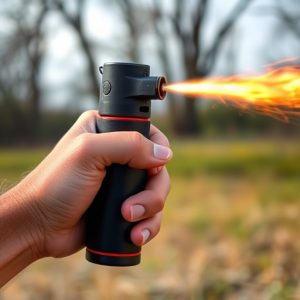Mastering Bear Spray: Top Self-Defense Techniques for Safety
Bear spray, containing capsaicin, is an effective deterrent against grizzly and black bears. To maxi…….
Bear spray, containing capsaicin, is an effective deterrent against grizzly and black bears. To maximize its effectiveness, understand its operation, follow best practices for application (like aiming for eyes, nose, mouth at 2-3 feet distance), and choose high-concentration, weather-resistant products from reputable brands. Mastering pepper spray's use and adopting a multi-layered safety strategy, including gear, noise making, and trail adherence, enhances self-defense against wildlife attacks.
“Enhance your outdoor safety with an essential tool in bear spray defense. This comprehensive guide explores the best pepper spray self-defense techniques, offering insights into ‘Understanding Bear Spray and Its Efficacy,’ ‘Choosing the Right Pepper Spray,’ and ‘Effective Application Techniques.’ Learn beyond spray strategies for comprehensive protection, including prevention tips, to navigate wild encounters confidently. Discover the top self-defense practices and stay safe in nature’s realm.”
- Understanding Bear Spray and Its Efficacy
- Choosing the Right Pepper Spray for Self-Defense
- Effective Application Techniques
- Beyond Spray: Additional Safety Measures and Prevention Tips
Understanding Bear Spray and Its Efficacy
Bear spray, also known as pepper spray designed for wildlife encounters, is a specialized self-defense tool used to deter aggressive bears. It’s one of the best pepper spray self-defense techniques against grizzly and black bears, which are responsible for a significant number of animal attacks globally. This spray contains capsaicin, the same ingredient found in chili peppers, that irritates the eyes, nose, and lungs of the target animal, temporarily incapacitating it.
Understanding how bear spray works is crucial when considering it as a defense mechanism. When used properly, bear spray can provide vital seconds to escape or regroup during an encounter. However, factors like weather conditions, angle of application, and proximity to the bear can impact its efficacy. Therefore, it’s essential to familiarize yourself with best practices for using bear spray, ensuring you have the right equipment, and understanding the recommended distances and techniques for optimal protection.
Choosing the Right Pepper Spray for Self-Defense
When considering bear spray as a self-defense mechanism against animal attacks, choosing the right pepper spray is paramount. The best pepper spray for self-defense should offer a high concentration of capsaicin, the active ingredient responsible for the burning sensation and temporary blindness that helps deter attackers. Look for sprays with a minimum concentration of 1% capsaicin, as this has been shown to be effective against bears and other large wildlife.
Additionally, consider factors like spray range, duration, and weather resistance. Sprays designed specifically for outdoor use often have longer ranges and are more durable, ensuring their effectiveness in various conditions. Knowing the spray’s reach can help you maintain distance during an encounter, while its longevity ensures you have enough time to escape. Always opt for reputable brands that provide clear instructions on usage techniques, as mastering the best pepper spray self-defense techniques is crucial for maximizing safety and effectiveness.
Effective Application Techniques
When it comes to the best pepper spray self-defense techniques, understanding effective application is key. The primary goal is to target the eyes and face, as this area is most sensitive to capsaicin, the active ingredient in pepper spray. Aim for the attacker’s eyes, nose, and mouth, ensuring a direct hit. The closest range for optimal effectiveness is approximately 2-3 feet (about 60-90 cm), but spraying from a safer distance of up to 15 feet (4.5 meters) can still cause a debilitating effect.
A common mistake is not spraying enough or in the right way. It’s better to use short bursts and aim for a cloud of spray rather than trying to directly hit an attacker’s face. This creates a barrier that limits their visibility, breathing, and ability to attack. After applying pepper spray, create distance quickly, as it typically takes 3-5 minutes for symptoms to subside, giving you precious time to escape or call for help.
Beyond Spray: Additional Safety Measures and Prevention Tips
Beyond Spray: Additional Safety Measures and Prevention Tips
While bear spray is an effective self-defense technique against animal attacks, it’s just one tool in your safety arsenal. The best pepper spray self-defense techniques should be accompanied by a comprehensive approach to prevention. Always carry essential survival gear like a reliable flashlight, a whistle, and a sturdy multi-tool when venturing into known wildlife areas. Make noise as you hike—talk loudly or play music—to deter potential predators who prefer to avoid confrontation. Stay on designated trails and make your presence known to minimize surprise encounters.
Regularly review and practice emergency procedures, such as how to properly deploy bear spray and what to do if an attack occurs. Educate yourself about local wildlife behavior and habitat to anticipate potential risks. Remember, preventing an attack is always more effective and safer than reacting to one. By combining these additional safety measures with the skilled use of pepper spray, you can significantly increase your chances of staying safe in bear country or other areas prone to animal encounters.
Bear spray is an effective self-defense tool, but it’s just one piece of the puzzle when it comes to preventing and surviving animal attacks. By understanding your local wildlife, carrying the best pepper spray for your needs, and mastering application techniques, you can greatly enhance your safety in wild environments. Additionally, implementing preventive measures like making noise while hiking and securing food properly can significantly reduce the risk of encounters. Remember, knowledge and preparation are key to ensuring your outdoor adventures remain enjoyable and secure.


